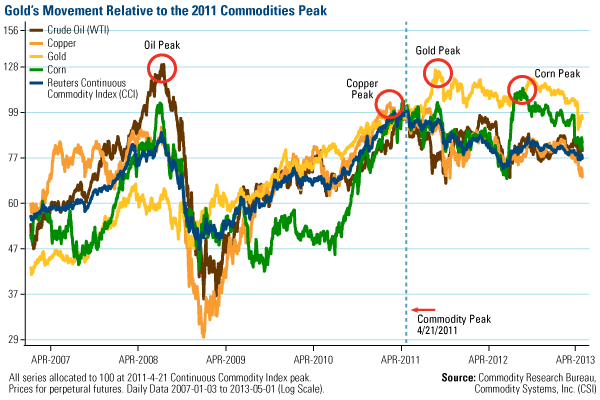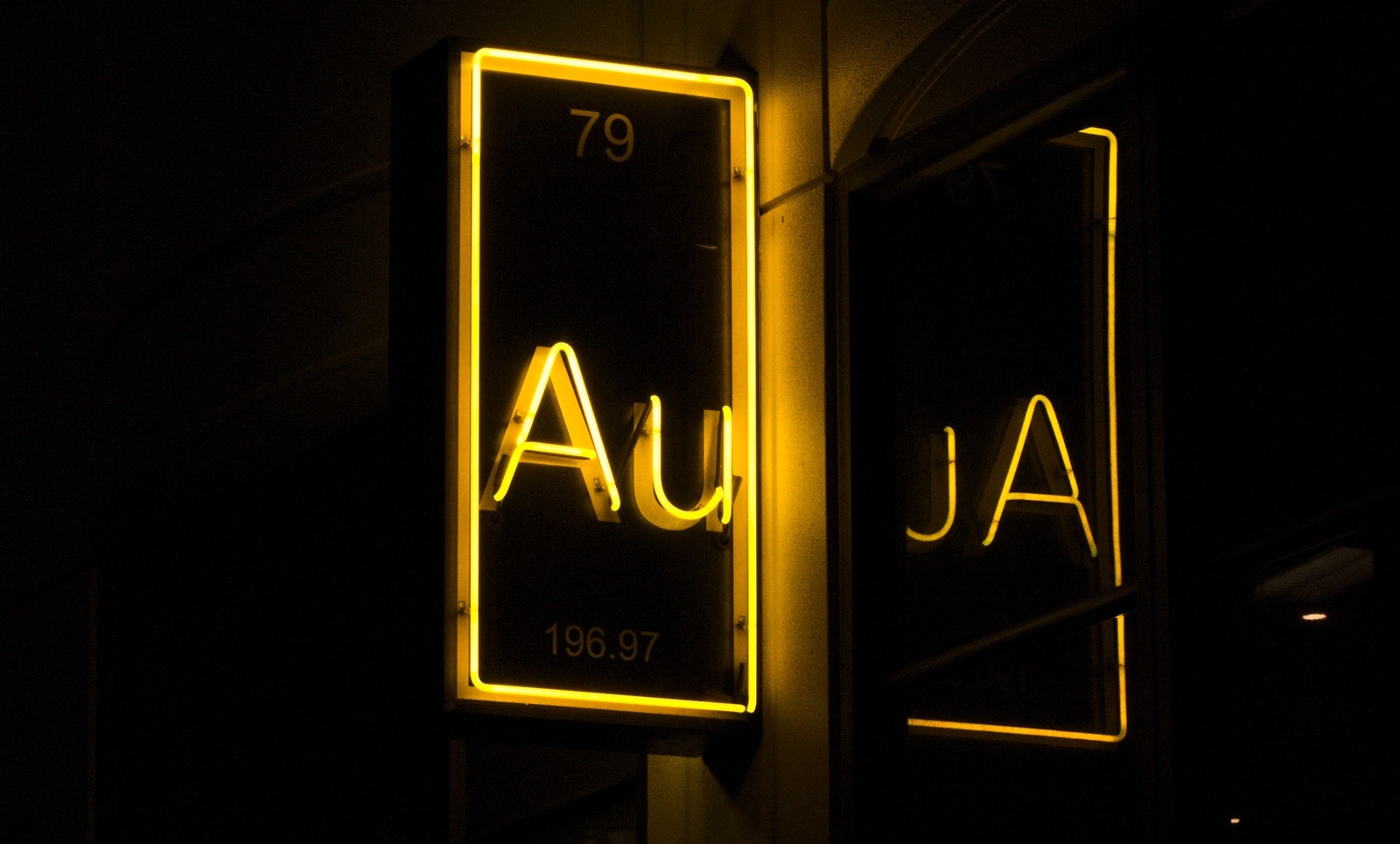Gold Market Radar (May 21, 2013)
For the week, spot gold closed at $1,359.55, down $88.65 per ounce, or 6.12 percent. Gold stocks, as measured by the NYSE Arca Gold Miners Index, fell 11.4 percent. The U.S. Trade-Weighted Dollar Index gained 1.27 percent for the week.
Strengths
- The chart above shows the price action of key commodities since 2007 plotted on the back of the Reuters’ Continuous Commodity Index (CCI). In the chart, the four commodities and the commodity index are equalized to 100 on April 2011, the time when the commodity index peaked. In comparison, gold’s performance is remarkable in relation to the other commodities following the April 2011 peak. Not only has gold outperformed, it is the only commodity that is close to its April 2011 value. Comparatively, the commodity index has lost roughly 23 percent, while copper declined by 30 percent. As such, despite the negative publicity gold has drawn in 2013, it appears it continues to be king among commodities when it comes to storing value.
- The World Gold Council issued its first quarter 2013 Gold Demand Trends report. The council reports demand for gold bars and coins was 10 percent higher in the first quarter compared to a year earlier, while demand for jewellery increased 12 percent. Similarly, central banks’ net purchases exceeded 100 tonnes for the seventh consecutive quarter. It is worth mentioning that these numbers provide evidence of strong physical demand from all sectors, even prior to the widely disseminated news of the skyrocketing demand for physical gold that followed the April 15 price drop.
- New Gold announced that it unwound a legacy gold hedge book at its Mesquite mine in California. The company paid $67.5 million to retire the hedge which called for delivery of 5,500 ounces of gold per month at a fixed price of $801 per ounce until the end of 2014. The remaining delivery totaled 110,000 ounces gold. The transaction was completed at an average gold price of $1,396 per ounce. By eliminating the hedged position, the company is now completely unhedged and fully levered to benefit from future upside in the gold price.
Weaknesses
- The U.S. dollar continues to gain against most other currencies, which traditionally translates into lower commodity prices. The dollar index, which measures the value of the greenback against a basket of six major currencies, surged to the highest levels since 2010. The strength was revived by a news article last Friday which speculated that the Fed may have already devised an exit from its $85 billion monetary easing program. This week, the dollar also received support from data showing that consumer sentiment rose to its highest level after the fall of 2008. The dollar has risen at an annualized rate of 25 percent so far this year.
- Money managers withdrew $1.27 billion from gold and precious-metals funds in the week ended May 8, according to analysts tracking money flows. This year’s outflows have reached $20.8 billion, the largest redemptions since the data began to be collected.
- Barrick Gold Corp reached a preliminary agreement with the Dominican Republic government to increase the share of profits from its Pueblo Viejo gold mine going to the Caribbean nation. President Medina of the Dominican Republic had demanded in February that the company renegotiate the contract signed with a previous government for the Pueblo Viejo mine, as he threatened to impose a windfall tax on profits. The tentative agreement would add to roughly $1.5 billion being directed to the nation over the project’s 30 year life. The company will be handing around half the cash flow obtained from the project to the government for the next three years, further straining the firm’s working capital. Although we welcome the resolution of the dispute, we believe the terms upon which the deal was reached are only to the benefit of the nation and do not present a symmetric share of the downside risk.
Opportunities
- In a Form 13F release of May 16, it was reported that Soros Fund Management LLC, the hedge fund founded by George Soros, significantly increased its gold related holdings. The most notable addition was the purchase of over $25 million worth of call options on the GDXJ Junior Gold Miners Index. In addition, the fund reportedly owns more than $239.2 million in gold related financial assets. The release contrasts the fund’s February release in which gold related exposure had declined significantly. Back then we reported that Soros being a savvy investor would have likely swapped his gold exposure to yen denominated positions, rather than outright selling. Regardless, this recent move by one of the world’s most closely followed hedge funds should help draw appetite for gold stocks and bode well for a surge in gold equities.
- The sell-off of Dundee Precious Metals subsequent to the Bulgarian elections is overdone according to Leon Esterhuizen of CIBC World Markets. The company issued a statement noting that it's "business as usual" at all of its operations, after the company's share price fell 15 percent following the elections on Sunday. The already contentious elections have become more controversial after Bulgaria's biggest political party said it will seek to have the result of Sunday's deadlocked election cancelled on grounds of a violation. As per the company, neither the Chelopech operation or Krumovgrad project are likely to be materially impacted by this political turmoil. We agree with Leon in that Dundee Precious is very attractive at current valuations as it remains an acquisition target for anyone needing access to its unique smelter in Namibia, one of a handful in the world that can treat high-arsenic-content concentrates.
- Additional exploration and metallurgical sampling performed by Klondex Mines on its Fire Creek project has revealed significant visible mineralization with grades as high as 496.6 grams per ton. Similarly, Gran Colombia Gold shared some of its recent exploration success during its first quarter earnings’ conference call. The company reported multiple intercepts of visible gold, as high as 663.32 grams per ton at its Segovia project. Encountering such high gold mineralization allows greater operational/development flexibility for miners, increases the likelihood of the project becoming a successful and profitable venture, and adds to the overall excitement around the project.
Threats
- Japan is helping create disinflationary growth around the world, according to the analysts at Cornerstone Macro. In their Portfolio Strategy report for this week, they argue that the fresh rounds of monetary easing, and in particular the actions by the Bank of Japan are a huge surplus for U.S. consumers, at least in the short run. One of their main arguments is that weak yen policies have provided support for the dollar, which has allowed equities to rise without a comparable rise in commodity prices. They argue that the outperformance of the S&P 500 relative to a commodity index is strongly, negatively correlated to the value of the Japanese yen. This correlation has been particularly strong since November when the Bank of Japan monetary easing program was announced.
- Nomura currency guru Jens Nordvig has turned very bullish on the U.S. dollar. He argues the U.S. dollar real effective interest rates are trading close to multi-decade lows, making them very likely to increase sharply. In addition, the rising likelihood of domestic energy independence, the overall decline of commodities, and the shrinking trade deficit should all bode well for the greenback. Nordvig is calling for meaningful gains by year end, which is consistent with many bulls’ call for the return of king dollar.
- Gold premiums in India, the world’s biggest buyer, more than doubled as the Reserve Bank of India limited imports by banks, on a consignment basis, to only those required to meet the genuine needs of exporters. The restrictions on bullion imports by banks are aimed at restraining a record current-account deficit. As a result, bullion dealers are not accepting fresh orders, and it remains to be seen if there will be another route to import the precious metal. Bloomberg reports the trade deficit widened in April to $17.8 billion from $10.31 billion in March as gold and silver imports more than doubled to $7.5 billion from a year ago.












